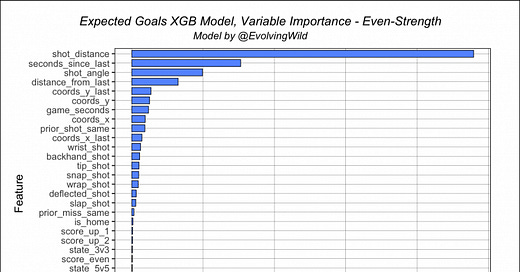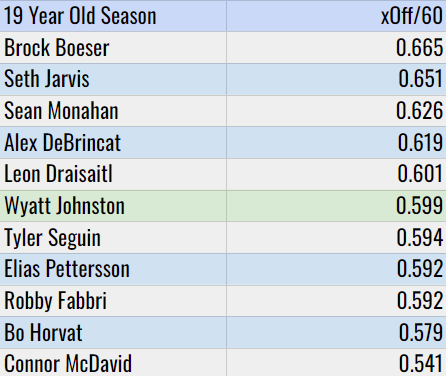Did I Overshoot Wyatt Johnston's 2023-2024 Season Projection? Or Undershoot?
Was I being too kind...or not kind enough?
I don’t think I went out on a limb or anything on Friday with my article on Wyatt Johnston. But I do think it needed a sequel. For those who didn’t read it here’s the TL;DR version: Johnston’s shift-to-shift impact on goals profiles like those of Clayton Keller, Evander Kane, Sean Monahan, and Brady Tkachuk (among others). Therefore, given that those players averaged 54 points in their following year, Johnston should score somewhere between 50 and 60 points. Now for the follow-up: did I overshoot or undershoot?
Just to be clear, this is gonna be a discussion about fancy stats so feel free to skip today’s reflections. Although in fairness, today’s piece is less about the stats themselves and more about the philosophy informing them. As in, why do we look at certain numbers and not others?
First let’s talk about the stat I chose. Because I’m too lazy to paraphrase myself, here it is again.
Evolving-Hockey has a stat called “Off” that refers to the goals scored above a typical healthy scratch forward (called EVO) plus that player’s power-play goals above a typical healthy scratch forward (called PPO). In other words, it refers to the offense we can reasonably expect from a player given the offense he generates from shift to shift at even strength, and on the power play.
If you’re new to fancy stats, or maybe you don’t give a shit but you’re here anyways and willing to listen, you might be wondering — why Off? By Off, I mean the aforementioned stat, not the righteous punk band*. Why not expected goals, WAR, or corsi, or something else?
A few reasons. For one, Corsi is just a plus/minus of shot attempts. Corsi might help us understand how well Johnston helps the team control the puck, but it won’t tell us anything about his talent with the puck. WAR is about broad value from shift to shift, not shooting value. Goals Above Replacement, on the other hand, gives us more clues about shooting performance. It’s not a silver bullet, granted. But what I like about these stats (to the extent that I understand them) is that instead of counting points, we get closer to counting offensive performance. Anybody can look dangerous for a stretch with an absurdly high shooting percentage. But not everyone can look dangerous with the puck shift in, and shift out.
Hence the stat. I wanted to look at Johnston’s shift-to-shift (in the interest of saving myself time I’ll be using ”STS” as an acronym for shift to shift) impact on goals, both at even strength — since he’ll play a lot there, I’m told — and the power play — since we know he’s now a mainstay on it. And I wanted to look at those numbers because my gut is telling that Johnston is capable of more than 41 points. Hell he was capable of more than 41 points this year.
Since I just wanted to know Johnston’s bottom line next year (how much he’ll produce), it seemed wise to look at a bottom line stat. However, let’s dig a little deeper. Evolving-Hockey does have an expected total offense stat (or xOff). It’s exactly like the Off number, just with extra credit given to the STS offense that the players were owed to the hockey gods instead of only the STS offense that the hockey gods allowed.
Quickly, because I think we take expected goal models for granted, here is how expected goals are weighted per Evolving-Hockey.
Notice how the four highest grades are given to the components that all make the most intuitive sense: shot distance, seconds between consecutive shots, shot angle, and distance between consecutive shots. As Micah Blake McCurdy once said, “crowds are expected goal models that talk.” The same is true on special teams (or uneven-strength, which is a phrase I never thought to use until now).
So, now that we have some concept of what these numbers mean, let’s add to the previous argument from the D Magazine article. And now let’s give Johnston credit for all the offense he could have created based on his STS offensive threat level instead of the STS offense he was rewarded for, based on his offensive threat level. Starting with expected goals above a typical healthy scratch forward, where does he rate then?
Johnston rates 14th overall for a 19-year old season (and 7th overall in individual expected goals for said season). For analytics skeptics, I understand that this is where fancy stats tend to lose people.
And I totally get it. “So you’re telling that according to expected Biscuits and Gravy per 60, Wyatt Johnston and Robby Fabbri are better than Connor McDavid? What kind of mathematical drugs is that model on?” Yes, it looks silly. But consider what we’re looking at. We’re looking at STS offense owed to the hockey gods, in all situations, for a 19-year old’s season. That’s it. The numbers aren’t saying that Johnston is better than McDavid. They’re saying that Johnston’s STS impact on expected goals was higher for his 19-year old season.
For skeptics, this might sound like a fancier way of saying Johnston had a better 19-year old season. What I would say is that you kind of have a point. However, with so many pieces being calculated, we’re bound to come up with some noise. At that point, it’s not the noise that’s problematic, but the lack of noise that is.
Sidebar: This is what I hate about hockey heads talking about stats as a place where “some you use, some of you don’t.” That’s the exact opposite of why we’re interesting in using them. You use them to have a better language about performance. Since the numbers, just like performances, are always subject to change, it’s the unfolding stories to look for; not complex numbers that go into simple buckets of Good versus Bad.
The more “noise” there is, the more potential insight we are to find. Consider this principle in reverse; as in, a number with no noise whatsoever. Take for instance, some of the top 15 worst plus/minus players of the 2022-2023 season.
Seth Jones (-38)
Jordan Kyrou (-38)
Tomas Hertl (-36)
Drake Batherson (-35)
Johnny Gaudreau (-33)
Jonathan Toews (-31)
Alex DeBrincat (-31)
Logan Couture (-30)
Is there anything instructive about this list? Does anyone believe these are some of the league’s worst players, or were they simply on some bad teams? Now let’s go back to our list to include their xOff ranking for their 19 year old season, and point totals that year. (Not sure how Brock Boeser and Matt Duchene got replaced on this xOff list but let’s roll with it for now.)
(9th) Matt Duchene. 55 pts.
(10th) Seth Jarvis. 40 pts.
(11th) Sean Monahan. 34 pts.
(12th) Alex DeBrincat. 52 pts.
(13th) Leon Draisaitl. 9 pts.
(14th) Wyatt Johnston. 41 pts.
(15th) Tyler Seguin. 22 pts.
(16th) Elias Pettersson. 66 pts.
(17th) Robby Fabbri. 37 pts.
(18th) Bo Horvat. 25 pts.
(19th) Connor McDavid. 48 pts.
Is there something instructive about this list? Why yes. With the exception of Fabbri** every single one of these players would go on to have more productive seasons, becoming either top six staples of their respective teams, or becoming the team’s top triggerman outright. I think what’s also interesting is that some of these players didn’t have big years. Horvat, Monahan, and Seguin didn’t look like stars, but their impacts were star-level. Rather than give us jack and shit like plus/minus, the xOff numbers give us a greater sense of offensive player tiers. Specifically ranking them might be a silly exercise (Horvat over McDavid, for example), but broadly referencing where they rank (elite, top six triggermen) is not. It’s not perfect. But it’s useful. Thankfully “useful” is merely the beginning of Johnston’s capabilities.
Not for nothing but JFresh has Johnston’s 2023-2024 projection card. While it undersells Johnston’s overall impact — there’s a well-rounded game in there that I think has yet to really take off, as I wrote about (paid subscribers only; although I will unlock it before the season starts FYI) — it does highlight one of Johnston’s greatest strength.
Thanks to Corey Sznajder’s superhumanly (is that a word?) diligent work, we now know that he and Pavelski aren’t just playing Mario Kart at home. Only two percent of the entire NHL project to be better than Johnston at deflection chances, which is actually higher than Pavelski himself.
To wrap this up, I’ll go ahead and say it: Johnston breaks 60 points. As long as Dallas takes the second power play unit seriously and takes Greedo off the second unit, there’s no reason why Johnston and Duchene in particular shouldn’t be serious threats on the man advantage. Johnston only had 3 goals on the PP (with a shooting percentage of 11 percent). His EV shooting percentage of 16 percent might be a little inflated (ok fine: it was the highest on the team), but he didn’t generate a ton of shots either. In fact he was 9th on the team in individual shots on net per 60, hilariously behind Fredrik Olofsson (or maybe not so hilarious; I was kind of hoping Dallas would keep Freddy).
The line of Benn-Johnston-Dadonov will slow down. But their 17 goals in 23 games in the regular season is a 60 goal pace through a full season. That would actually outpace the Hintz line in goals (who were on track for 58). I don’t expect it to happen, and it won’t. But it’s clear that they generate offense at a high level. So yea. This is gonna be a big year for Johnston. And yes, I’ve been somewhat down on the line given Benn and Dadonov’s age, and the fact that they’re actually quite bad defensively. But DeBoer is gonna have an easy fix if they ever slow down with one, Matt Duchene. In which case, Johnston will proceed to leave Earth.
*Punk is definitely a genre I feel like I “outgrew” but I’ve always loved bands that wore some of the genre’s influences on their sleeve, like Bodycount and Biohazard.
**Fabbri has had some rotten luck when it comes to injuries. He’s another player that really got jerked around by the lack of development at the NHL level (cough, Hitchcock), but the crossfire of his knees failing him took his prime outright.









You did not overshoot, I believe. Like you said the second PP unit might be a difference maker. Compared to the beginning of last season, it's a night and day difference : Duchene, Dadonov, Harley. These guys were not in the team.
I hope Stars can build two strong PP units with different dynamics. Similar than we had in the bubble days. PP1 was very good with veteran players : Benn, Seguin, Pavs, Klinger. When that didn't work then came the young guns blazing, looking for quick resolution : Miro, Roope, Guri, ...
This kind of setup would be a difference maker with Wyatt leading. I have no doubt that it will happen.
I can't remember if you've thrown out a preferred line combo with ideal wings for Wyatt (you have written 10 articles on the young man). I know you mentioned Duchene, but I'm thinking longer term. Doesn't even have to be someone(s) currently on the roster, but maybe a prototype. If you have discussed this, I apologize.